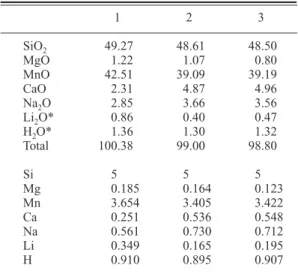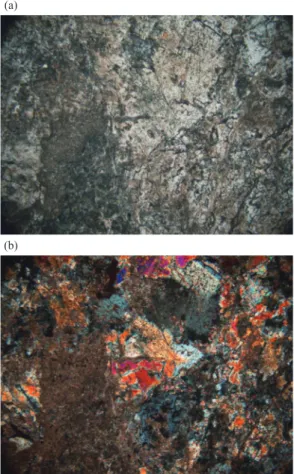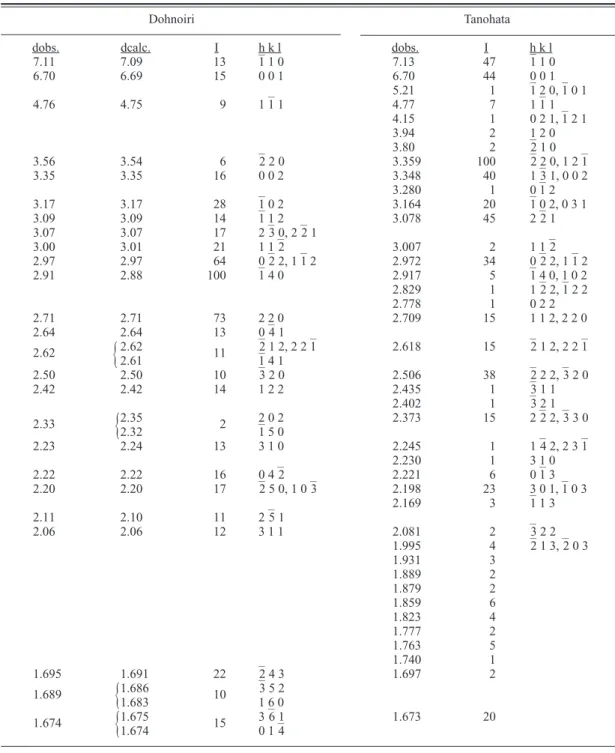Introduction
Natronambulite, (Na,Li)(Mn,Ca)
4[Si
5O
14OH], was first described from the metamorphosed bed- ded manganese ore deposit of the Tanohata mine, Iwate Prefecture, Japan by Matsubara et al.
(1985), as the Na-dominant member of nambu- lite, (Li, Na)Mn
4[Si
5O
14OH], in which Li Na (Yoshii
et al., 1972). However, Matsubara et al.(1985) considered the mineral not to be a mere Na-dominant member but pointed out the essen- tial nature of Ca replacing Mn. Prior to the first find of this mineral, the similar material had been found in the Kombat mine, Namibia, by von Knorring et al. (1978), who handled it as nambu- lite due to the reason that the original nambulite was chemically characterized as LiNaMn
8- [Si
5O
14OH]
2with Li : Na 0.51 : 0.49 (Yoshii et
al., 1972), while the Kombat material has Li :
Na 0.40 : 0.60, and the authors considered the chemical difference between two to be too in- significant to create a new species.
Synthesis of LiMn
4[Si
5O
14OH] was succeeded by Ito (1972) prior to the discovery of nambulite.
He also acquired synthetic (Na,Li)Mn
4- [Si
5O
14OH], but failed to obtain synthetic pure Na end member, or NaMn
4[Si
5O
14OH]. Accord- ing to his personal communication he remarked very slow reaction speed of gel mixture of em- ployed ingredients for NaMn
4[Si
5O
14OH] and possibility of disintegration of product into two, synthetic serandite (NaMn
2[Si
3O
8OH]) and py- roxmangite (Mn
7[Si
7O
21]).
The present natronambulite contains essential Ca in place of Mn as seen in the original analy- sis, substantiating the interpretation as to the ne-
Natronambulite from the Dohnoiri mine, Kanuma City, Tochigi Prefecture, Japan
Satoshi Matsubara
1, Akira Kato
1, Ritsuro Miyawaki
1, Yoshiro Komuro
2and Yoshio Okada
31Department of Geology and Paleontology, National Museum of Nature and Science, 3–23–1 Hyakunin-cho, Shinjuku, Tokyo 169–0073, Japan
2Komuro Hoshoku, No. 102, 2–30–6 Hakusan, Bunkyo, Tokyo 112–0001, Japan
3843–3 Yumoto, Hakone-machi, Kanagawa 251–0311, Japan
Abstract Natronambulite from the Dohnoiri mine was found as the second occurrence in Japan.
It is an essential constituent of bedded manganese ores formed by very weak metamorphism. The other manganese minerals are braunite, rhodochrosite and rhodonite. They occur as minute grain aggregates forming fine bands with or without quartz. After the calculation of Li2O and H2O con- tents, EDS analyses are idealized as (Na,Li,Ca)(Mn,Ca,Mg)4[Si5O14(OH,O)], where NaLi, MnCa, Mg and OHO, substantiating the original interpretation of essential nature of Ca substi- tuting Mn. Natronambulite and nambulite in Japan have been found in weakly to moderately meta- morphosed bedded manganese ore deposits which are principally developed in such a siliceous rock as chert in Jurassic mélange. The ore minerals therefrom include braunite without exception.
It is thus very likely that the oxidizing condition might have helped the concentration of lithium.
Two natronambulites in Japan were found from a member of low grade siliceous bedded man- ganese ores, whereas nambulite are found as veinlets cutting low to high grade manganese ores in all the known Japanese localities. These two lithium-manganese silicates might have been con- fused due to the color with rhodonite or pyroxmangite, especially high iron materials of the former, suggesting the more common occurrences.
Key words : natronambulite, Dohnoiri mine, manganese ore.
cessity of larger divalent cation than Mn
2, facil- itating the substitution of Na for Li, i.e., the sub- stitution of larger cation for smaller one.
Occurrence
The Dohnoiri mine is located at about N 36°32 36 and E 139°38 20 , and operated for manganese ore about 50 years ago. Currently some small dumps are left around the collapsed portal. Considering from the contents of dump materials and exposures nearby the portal, the ore deposit consists of ore beds of manganese minerals developed within bedded or massive chert beds. The principal ore-forming minerals are rhodochrosite, rhodonite, hematite, braunite and natronambulite. Gangue minerals are quartz, albite and barite. Besides them minor pyrite grains are involved within low grade manganese ores composed of rhodonite and quartz.
Natronambulite occurs as light orange to brownish yellow very minute grains forming bands composed of aggregates with fine-grained quartz. Their individual grains are of microscop- ic dimensions (Fig. 1). Natronambulite is easily recognized due to the color. It’s light orange to brownish yellow color is discernibly different from light pink color of rhodonite. Aggregates of natronambulite-quartz and rhodonite-quartz are closely accompanied by light brownish hematite- quartz bedded aggregates that develop con- choidal fracture if crashed. This suggests the practical absence of recrystallization, meaning the extremely weak metamorphic effects. Some of ores accompany colorless to gray chert with conchoidal fracture as well as the ores. Also, some ores are intersected by veinlets of colorless barite, which is uniquely coarser-grained, and a light yellow fibrous amphibole developed parallel to veinlets walls attaining a centimeter long.
Under the microscope, natronambulite occurs as a minute grain with quartz and rhodochrosite, though the mineral grains tend to form minute aggregates of less than millimeter size (Fig. 2).
Some interstices of quartz grains are filled in al- bite of similar size. In aggregates of natronambu-
lite and quartz, veins of minute fiber crystals of amphibole are observed (Fig. 3). Although the amphibole resembles Mn-rich richterite, it has been subjected to current study. It is visually dis- tinguishable from natronambulite due to its fi- brous nature and less orange or brownish and lighter yellowish color.
Chemical composition
The electron microprobe analyses were made using Link Systems energy dispersive X-ray spectrometer (QX-2000). The results of the analyses are given in Table 1. All of them have low totals, which are considered to be due to Li
2O and H
2O. The basis of calculation taking Si 5 is warranted due to the absence of Al
2O
3. Since all of them gave slight excess of divalent cations, a part of Ca is transferred to the site for Li and Na, requiring slight deficiency of H
2O for charge balance. The addition of above compo- nents is validated because all summations of analyses are nearly ideal.
The estimated Na/(Na Li) ratio situated be- tween the original (0.80) and Kombat material (0.60) serves to confirm the existence of continu- ous solid solution series within the compositional range of natronambulite, if the appropriate amount of CaO is involved.
Table 1. Chemical composition of natronambulite
1 2 3
SiO2 49.27 48.61 48.50
MgO 1.22 1.07 0.80
MnO 42.51 39.09 39.19
CaO 2.31 4.87 4.96
Na2O 2.85 3.66 3.56
Li2O* 0.86 0.40 0.47
H2O* 1.36 1.30 1.32
Total 100.38 99.00 98.80
Si 5 5 5
Mg 0.185 0.164 0.123
Mn 3.654 3.405 3.422
Ca 0.251 0.536 0.548
Na 0.561 0.730 0.712
Li 0.349 0.165 0.195
H 0.910 0.895 0.907
*: calculation
Fig. 1. The banded structure of natronambulite (orange), rhodonite (pink) and quartz (white). Specimen is ap- proximately 12 cm wide.
Fig. 2. Photomicrographs of natronambulite. a:
one polar, b: crossed polars. Field view is ap- proximately 1 mm wide.
Fig. 3. Photomicrographs of minute prismatic crystals of Mn-bearing amphibole including in natronambulite. a: one polar, b: crossed polars.
Field view is approximately 1 mm wide.
Table 2. The powder X-ray diffraction pattern for natronambulite.
Dohnoiri Tanohata
dobs. dcalc. I h k l dobs. I h k l
7.11 7.09 13 –
1 1 0 7.13 47 –
1 1 0
6.70 6.69 15 0 0 1 6.70 44 0 0 1
5.21 1 –
1 2 0, – 1 0 1
4.76 4.75 9 1 –
1 1 4.77 7 1 –
1 1
4.15 1 0 2 1, –
1 2 1
3.94 2 1 2 0
3.80 2 –
2 1 0
3.56 3.54 6 –
2 2 0 3.359 100 –
2 2 0, 1 2 – 1
3.35 3.35 16 0 0 2 3.348 40 1 –
3 1, 0 0 2
3.280 1 0 –
1 2
3.17 3.17 28 –
1 0 2 3.164 20 –
1 0 2, 0 3 1
3.09 3.09 14 –
1 1 2 3.078 45 2 –
2 1
3.07 3.07 17 2 –
3 0, 2 – 2 1
3.00 3.01 21 1 1 –
2 3.007 2 1 1 –
2
2.97 2.97 64 0 –
2 2, 1 –
1 2 2.972 34 0 –
2 2, 1 – 1 2
2.91 2.88 100 –
1 4 0 2.917 5 –
1 4 0, 1 0 2
2.829 1 1 –
2 2, – 1 2 2
2.778 1 0 2 2
2.71 2.71 73 2 2 0 2.709 15 1 1 2, 2 2 0
2.64 2.64 13 0 –
4 1
2.62
{
2.62 11 –2 1 2, 2 2 –1 2.618 15 –
2 1 2, 2 2 – 1
2.61 –
1 4 1
2.50 2.50 10 –
3 2 0 2.506 38 –
2 2 2, – 3 2 0
2.42 2.42 14 1 2 2 2.435 1 –
3 1 1
2.402 1 –
3 2 1
2.33
{
2.352.32 2 2 0 2– 2.373 15 2 –2 2, –3 3 01 5 0
2.23 2.24 13 3 1 0 2.245 1 1 –
4 2, 2 3 – 1
2.230 1 3 1 0
2.22 2.22 16 0 4 –
2 2.221 6 0 –
1 3
2.20 2.20 17 –
2 5 0, 1 0 –
3 2.198 23 3 0 1, –
1 0 3
2.169 3 –
1 1 3
2.11 2.10 11 2 –
5 1
2.06 2.06 12 3 1 1 2.081 2 –
3 2 2
1.995 4 –
2 1 3, – 2 0 3
1.931 3
1.889 2
1.879 2
1.859 6
1.823 4
1.777 2
1.763 5
1.740 1
1.695 1.691 22 –
2 4 3 1.697 2
1.689
{
1.6861.683 10 –3 5 21 6 01.674
{
1.6751.674 15 3 0 1 –6 1– 1.673 204 Dohnoiri: present study
Tanohata: Matsubara et al. (1985)
X-ray crystallography
The powder X-ray diffraction pattern was ob- tained using a Gandolfi camera, 114.6 mm in di- ameter, employing Cr Ka radiation (Table 2).
The unit cell parameters are: a 7.624(5),
b11.605(9),
c6.738(3) Å, a 92.96(6)°,
b94.75(5)°,
g106.26(6)°,
V568.7(6) Å
3. Though the pattern is apparently similar to that of rhodonite or pyroxmangite, it corresponds well to that of the original one (Matsubara et al., 1985). As the compositional variation of natro- nambulite yields minor variation in powder X- ray diffraction pattern, it is very likely that the similarity to rhodonite or pyroxmangite has in- duced the confusion with this mineral.
Consideration
In addition to the retained bedded texture, fine grain size of natronambulite as well as the asso- ciated quartz suggests the lesser degree of influ- ence of metamorphism. It is highly likely that all the component of natronambulite had been con- centrated prior to its formation.
The Na : Li ratio in the original natronambulite is 0.82 : 0.18. Matsubara et al. (1985) have con- sidered that the entrance of Na in place of Li ne- cessitates that of larger cation in place of Mn such as Ca on the basis of the unique original analysis in which the quantitative determination was made by wet method. The chemical analyses of the present material substantiate this conclu-
sion; higher CaO content than the original one and no mutual correlation between Li
2O and CaO contents.
Natronambulite and nambulite are apparently characterized by orange to brownish yellow color. However, they have been miss-identified as rhodonite or pyroxmangite to date, since some of high iron-bearing rhodonite has orange brown color similar to those of natronambulite and nambulite. This evidence may lead to the new find of these Li-bearing pyroxenoids in lower grade siliceous manganese ores from weakly to highly metamorphosed bedded manganese de- posits.
Acknowledgements
We thank Mrs. M. Shigeoka for her assistance in EPMA analysis.
References
Ito, J., 1972. Synthesis and crystal chemistry of Li-hydro- pyroxenoids. Mineralogical Journal, 7: 45–65.
Matsubara, S., A. Kato & T. Tiba, 1985. Natronambulite, (Na,Li)(Mn,Ca)4Si5O14OH, a new mineral from the Tanohata mine, Iwate Prefecture, Japan. Mineralogical Journal, 12: 332–340.
Von Knorring, O., Th. G. Sahama & R. Törnroos, 1978.
Second find of nambulite. Neues Jahrbuch für Miner- alogie, Monatshefte, 346–348.
Yoshii, M., Y. Aoki & K. Maeda, 1972. Nambulite, a new lithium- and sodium-bearing manganese silicate, from the Funakozawa mine, northeastern Japan. Mineralogi- cal Journal, 7: 29–44.


